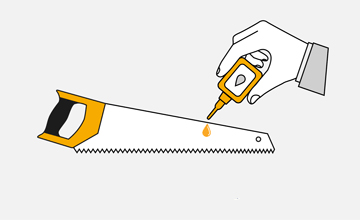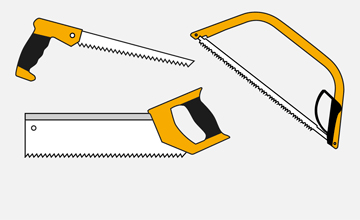When choosing your saw, determine what type of toothing you need. Material, fiber direction and cutting quality are important for this. For example, particularly fine cuts in solid wood require very sharp pull teeth, which the Japanese saws offer. On the other hand, the narrow saw blades of the hacksaw with coarse planing teeth are best suited for damp wood. A medium-length fox tail is ideal for universal woodworking along and across the grain. The shape and size of the saw blade are also important aspects for selection.
Traditional handsaw with dynamic saw blade, can be used for woodworking or for thin PVC.
Traditional pull saw based on the Japanese model, enables particularly fine and clean cuts with minimum effort.
Multi-purpose saw for fine woodworking, with toothed rim for sawing out slots without drilling, also suitable as a mitre saw.
Multi-purpose fine saw for carpentry work, very suitable as a mitre saw, also for processing plasterboard and plastic panels.
Ideal tool for recesses and round cuts in wooden panels or for hard-to-reach areas.
Particularly sturdy handsaw with coarse teeth for construction sites, saws porous/gas concrete.
To maintain the cutting performance of your saw for as long as possible, regular maintenance of the teeth and blade is necessary.

Cleaning
Clean the blades regularly with a cloth. Stubborn green residues or resin residues can be removed with kerosene, spirit or spray oil. Rubbing in before use prevents the blade from jamming. Resharpen unhardened teeth to ensure a clean cut at all times. Dry damp or wet tools thoroughly after use to protect them from rust.

Storage
If the saw will not be used for a longer period of time, rub it with an oily cloth and store it in a dry place, preferably in a hanging position. Clamped saw blades should be released when not in use to maintain the clamping force of the saw. Lubricate or oil moving parts as required.
Preferably with commercial training or freight forwarding experience,
but this is not a requirement. Knowledge of English is an advantage.